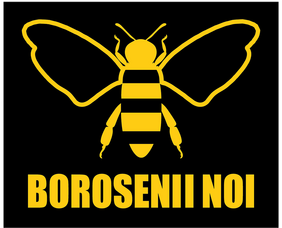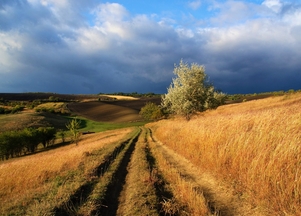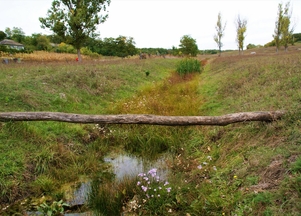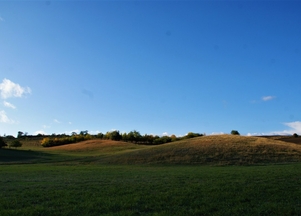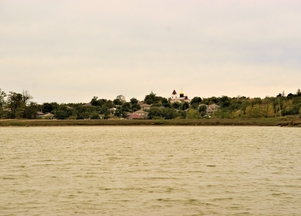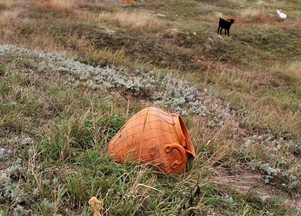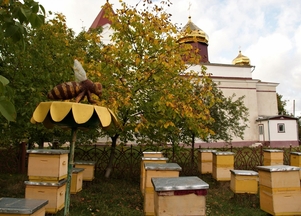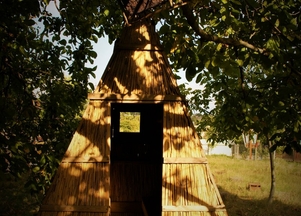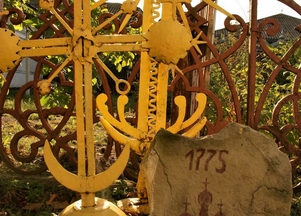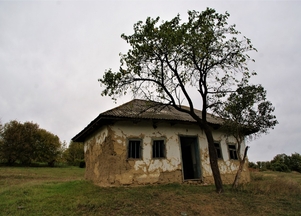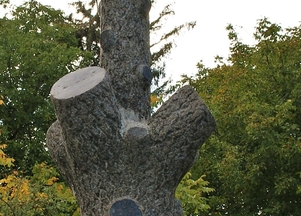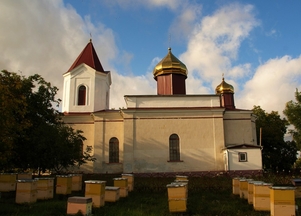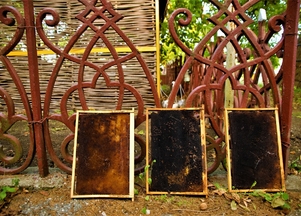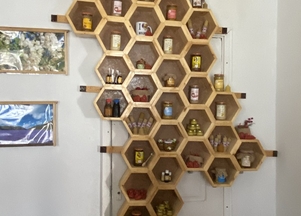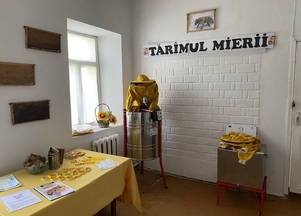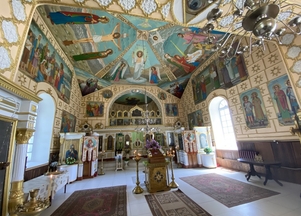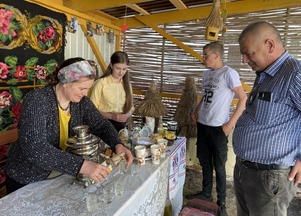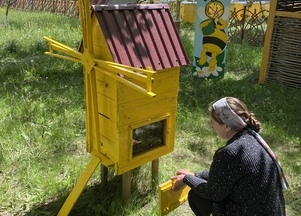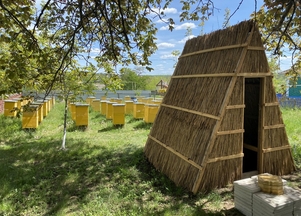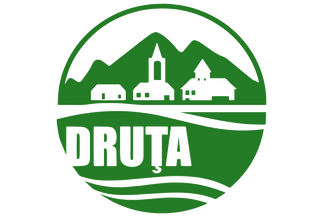Borosenii Noi
History
Attested on 10 July 1663 with the merged village of Borosenii Vechi. Village situated at the mouth of the Camenca River, in a region of plateau and hills, 8 km north-west of the town of Riscani. The hill that separates Borosenii Noi from Pîrjota has an altitude of 248 m. From the peak, a secular forest with numerous springs, descends to the gate of the village - a rare sight in the plain of Balti.
Since ancient times there is a legend in Borosenii Noi about the Land of Honey. The village of Borosenii Noi is surrounded by forests - a true oasis of tranquillity and visual delight. The tall and proud trees invite you for a walk. The Borosans have been lured to such a walk. Here the Borosans discovered bees in the hollows lined in the white trunks of the trees. They were industrious, ingenious people, lovers of work, of nature and of these insects, and decided to domesticate them. They wove baskets out of loam and glued them together with clay. Thus began man's hobby of beekeeping. They became the source of existence, health and wealth for the Borosans. But the territories between the Prut and the Dniester were often attacked by nomadic hordes of the Tatars, by Turkish armies that even reached the territory of the village of Boroseni. The Borosans, being wise, thought how to defend themselves against their enemies. So they came up with an idea: they laid out baskets of bees and tied them together with braided string, and brought the end of the string to the threshold of the house. As the enemies approached they pulled the string, the baskets toppled over and the bees met them, stinging them mercilessly. The bees emerged victorious. They saved the lives of the natives.
The Camenca stream divides the village in two, and the natural boundary in the local dialect is called "Brăzdenii". And not by chance. It used to draw a blue furrow between Borosenii Vechi and Borosenii Noi. Over time the saddles merged, forming a single human hearth. The legend handed down from generation to generation says that the name of the village derives from a strong-willed blacksmith whom the locals nicknamed Borosan (Sledgehammer). Whether this is true is hard to say. His written biography of the locality begins on 10 July 1663. This date is fixed in the Statute of the commune and is supported by several researchers.
One of the most worthy landowners of the estate "Borosenii from the Camenca riverbed" was Toader Rîșcanu, who bought it for 200 gold coins, cash money, from the descendants of Iz, who owned it in the second half of the 17th century from the merchant Sandu Adam. Grigore Ghica Voievod, on 14 December 1733, confirmed the bargain by a sovereign act.
Around 1750, the landowner Scalețki put a guard on the edge of his estate - old Toader Borosanu, from Boroseni. He built a shack on the bank of the nearby stream. The place was beautiful. In front of the house there was a stream with crystal-clear water, and behind the house stretched thousands of hectares of forest. The landlord soon moved about 16 other families to live here, because a greedy neighbour had appeared on the south side of his estate. The new village began to be called Borosenii Noi.
In the years 1812-1821 in Borosenii of the Ciuhur district, which had 68 peasant farms, 6 bachelors, 1 priest, 1 deacon, 2 ponds and a mill, we find landlords Iordache Rîșcanu and Vasile Iamandi. The latter had the title of "nobleman without a job" and owned 28 peasant families in Borosenii Vechi. Borosenii Noi on the estate of the boyar Rîșcanu grew faster, in 1859 there were 84 houses here. The church built of stone in 1845 employed priest Gheorghe Serghievschi, deacons Gheorghe Bociucianu, Gheorghe Hăbăsescu and teacher Ioan Vartic. In Borosenii Vechi there was also a halfway house for those arrested by the Tsarist gendarmerie in Siberia. In the village there was also a post office with 6 coaches and 18 horses.
On January 1, 1865 the landowner Iamandi owned 1,630 ares (1 are = 100m2) of land in Borosenii Vechi, the landowners Rîșcanu and Ciolacu had 3,800 ares in Borosenii Noi. On 1 February Ecaterina Iamandi publicly sells 400 ares of her inherited land to pay a debt of 41,237 rubles to the boyar Nicolae Micloș.
The village of Borosenii Vechi was losing population every year, Borosenii Noi was imposing itself more and more authoritatively on the administrative level, developing the estate fast and well. The number of landlords increased, new landlords appeared. G. Sciuca owned in 1892 1.425 ares, I. Vasilevschi - 460 ares, G.Rîșcanu - 974 ares, S. Stepanovschi - 578 ares, Maria Ciolacu had a large estate - 2.088 ares; all the peasants of the area, taken together, owned only 1.017 ares. At the 1897 census Borosenii Noi was included in the list of localities in the Russian Empire with more than 500 inhabitants, 835 people lived here at that time (427 men and 408 women).
On March 15, 1902 the nobleman Grigore Sciuca gave to the priest Alexei Onica and the teacher Maria Filipova from the parish school a set of icons, church ornaments and old books of great value. In the same year Maria Andreevna, having died after a difficult illness, was buried with full honours in the churchyard. Today a massive cross surrounds her final resting place, on holidays grateful descendants lay flowers here, light candles. Good deeds live long.
Zamfir Arbore in the Geographical Dictionary of Bessarabia (Bucharest, 1904) describes the locality in a telegraphic language: "Boroseni-Noui, large village, in the Balti county, situated in the Camenca valley. It is part of the district Copăceanca. Number of houses 151; one church dedicated to St. Nicholas; population 1,270 souls. The peasants own 1,017 ares, and the owners: Rîșcan 724 ares; Ciolac 2,088 ares; Wasileski 650 ares. Surrounding the village are vineyards and gardens with trees".
He also explains where the missing settlement was and what it presents:
"Boroseni-Vechi, village, in Balti county, situated in a hillock at the bottom of the Copăceanca valley; it is also called Boroșeni. It has 17 peasant houses, with 42 souls. Owners: E. Iamandi has 700 ares; Vasile Iamandi 700 ares. The peasants have no land".
In 1910 only 9 houses with 52 inhabitants remained in the village of Borosenii Vechi. Borosenii Noi numbered 213 hamlets, 727 inhabitants, with 1,087 ares.
A year later Lavrentie Macovei starts a steam mill here. In 1915, the secular school had 60 pupils, the parish school - 70.
The contemporary generation, and this does it great honour, has established and keeps with piety the list of ancestors fallen in the First World War. Thanks to the efforts of the teacher Pancratie Maznic, all 28 of his fellow countrymen were brought out of anonymity.
442 peasants from the two villages receive in autumn 1922 from the Romanian Institution "Casa Noastra", empowered to implement the agrarian reform, 2,142 ha of land confiscated from landlords and monasteries.
Having been endowed with land (the age-old dream of the ploughmen), now a different flour is being ground at the mill of time. The peasants became more industrious, the fields more generous. All that remained for the statisticians to do was to note the radical changes in society, in each individual village.
"Borosenii Noi. Riscani district, county Balti. In 1845 the church "St. Nicholas" was built in stone at the expense of the owner Toader Cocean. The village was founded by the Moldovan owner Surdu.
Buildings 321. Residents: 548 men and 573 women, total 1,121. Steam mill. Mixed primary school, Orthodox church, rural post office, town hall". (Statistical Dictionary of Bessarabia. Chisinau, 1923)
The school had also something to be proud of. In 1933, 256 pupils sat in the desks here every day, taught by four teachers - Eufrosinia Bordeianu, Anastasia Gulea, Stefan Gasnaș and Ioan Zamfir. This was one of the most advanced schools in the county Balti. But in the autumn of 1940 the pupils had their textbooks changed, they were forced to learn by heart poems in Cyrillic script about "daddy Stalin". Red flags flew on administrative buildings, a different currency was put into circulation in shops, with a hammer and sickle.
A year later, when the German 11th Army, commanded by General-Colonel Ritter von Schobert, was advancing massively from the Prut, covering all of Balti County. Near Borosenii Noi a saboteur fired several rounds at a German column. The Fascists blockaded the village, took 17 men hostage, took them to the banks of the Camenca river and shot them. Peaceful and innocent people fell prey to this act of vandalism.
On the morning of 31 Oct 1943, a red flag was flying over Birman's estate in Boroseni, and a red flag was flying over the beet hill. It was flown by the communists Ion Costiuc and Nicolae Motruc, who, having been arrested by the Romanian gendarmerie, admitted to being part of an illegal subversive organisation with its centre in the village of Balan. Five days later, 17 more "illegals" from Sofia, Cubolta, Cuza Voda and Moara de Piatra were brought to the Balti prison in handcuffs.
Of the Borosenians mobilized by the Soviets, 46 men did not return home from the war.
Neither famine nor deportations spared the town. On 10 November 1940, the Soviet administration registered 1,639 inhabitants in Borosenii Noi, but on 1 August 1949 - only 1,357.
Legend
Shchiopu's stable
Once a shepherd without a leg came to the landlord Arestic and agreed to sell him the pasture near the Moscal pond.
Then he brought a flock of several hundred sheep, made sheepfolds, built a house and began to live there in winter and summer by himself.
One winter, a pack of wolves had taken to his stables. Once, when the wolves started circling the sheepfolds, he came out of the house with a loaded gun, fired and killed one of the wolves. It turns out he didn't shoot the wolf, because the pack pounced on him and tore him to pieces.
Since then, this place on the village's estate has been called "La stâna lui Șchiopu".
The tradition is still preserved today. One of the village's sheepfolds, the sheepfold of Efrim Stepan - the most famous sheep farmer in the village - now stands on this site.
At present, there are 3 stables in our village, this being one of the main occupations, so the people of the village feel at peace.
Mounds at the entrances to the village
The old people used to tell that one of the first settlements in our land was the village "Grădini". It was a small village of about 30-35 square kilometres and its inhabitants were on duty at the "mound". This was the command of the king, to build mounds on the highest places, and when enemies entered the country, the guards of these mounds had to light fires on them, in order to inform the king in time.
Beautiful places
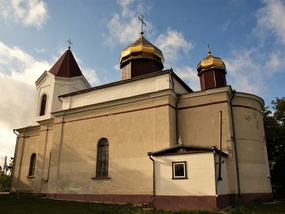
Church of St. Paraskeva
You'll discover the history of the church that broke people's souls, have tedeum for health and learn about the lives of saints and parables. In this holy place, "Cuvioasa Parascheva", there is a copy of the icon of the Mother of God from Gîrbovăț painted in 1885 in Iași. The icon that you can only find here is the icon of the saints of Moldavia, the icon of St. Nicholas that has remained untouched since the time of the Turks.
Read more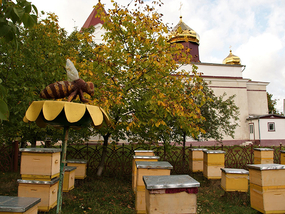
The apiary and the "Land of Honey" Museum
Today the holy place - "Cuvioasa Parascheva" is enjoyed by the faithful people of the village having in its garden an apiary and a new stone church built by the landlord Caceaun in 1775. Boroseni's land of honey is a unique apiary in the north of Moldavia, where the soul is soothed with prayer and the hum of bees. "Go to the bee and see how industrious it is and what skilful work it does. Her work is used for health by kings and commoners alike. She is loved and praised by all" ( Bible parables 6,9.)
Read moreVideo presentation
In the following video presentation, you will be invited to discover the beauty of the banks of the Prut River in the Republic of Moldova. This picturesque area is known for its idyllic landscapes, where the river Prut flows quietly through the hills


 ro
ro
 ru
ru
